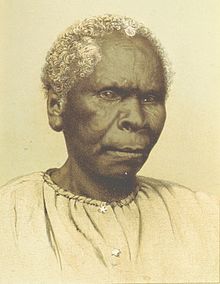Truganini
| Truganini (Trugernanner) | |
|---|---|

Truganini in 1870.
|
|
| Born | c. 1812 Bruny Island, Australia |
| Died | 8 May 1876 (aged 63–64) Hobart, Australia |
| Other names | Truganini, Trucanini, Trucaninny, and Lallah Rookh "Trugernanner" |
| Known for | Last surviving full blooded Tasmanian Aboriginal |
| Relatives | Very close to Ouray Ouray, if not her daughter. |
Truganini (c. 1812 – 8 May 1876) was an Aboriginal Tasmanian (Palawa).
There are a number of other spellings of her name, including Trugernanner, Trugernena, Truganina, Trugannini, Trucanini, Trucaminni, and Trucaninny. Truganini was also widely known by the nickname Lalla(h) Rookh.
Truganini was born in 1812 on Bruny Island, located south of the Tasmanian capital Hobart and separated from the Tasmanian mainland by the D'Entrecasteaux Channel. She was a daughter of Mangana, Chief of the Bruny Island people. Her name was the word her tribe used to describe the grey saltbush Atriplex cinerea.
In her youth she took part in her people's traditional culture, but Aboriginal life was disrupted by European invasion. When Lieutenant-Governor George Arthur arrived in Van Diemen's Land in 1824, he implemented two policies to deal with the growing conflict between settlers and the Aboriginals. First, bounties were awarded for the capture of Aboriginal adults and children, and secondly an effort was made to establish friendly relations with Aboriginals in order to lure them into camps. The campaign began on Bruny Island where there had been fewer hostilities than in other parts of Tasmania.
When Truganini met George Augustus Robinson, the Protector of Aboriginals, in 1829, her mother had been killed by sailors, her uncle shot by a soldier, her sister abducted by sealers, and her fiancé brutally murdered by timber-cutters, who then repeatedly sexually abused her. In 1830, Robinson moved Truganini and her husband, Woorrady, to Flinders Island with the last surviving Tasmanian Aboriginals, numbering approximately 100. The stated aim of isolation was to save them, but many of the group died from influenza and other diseases. In 1838 Truganini also helped Robinson to establish a settlement for mainland Aboriginals at Port Phillip. After about two years of living in and around Melbourne, she joined Tunnerminnerwait and three other Tasmanian Aboriginals as outlaws, robbing and shooting at settlers around Dandenong, which triggered a long pursuit by the authorities. The outlaws moved on to Bass River and then Cape Paterson. There, members of the group murdered two whalers at Watsons hut. The group was captured and sent for trial for murder at Port Phillip, and a gunshot wound to Truganini's head was treated by Dr Hugh Anderson of Bass River. The two men of the group were found guilty and hanged on 20 January 1842. Truganini and most of the other Tasmanian Aboriginals were returned to Flinders Island several months later. In 1856, the few surviving Tasmanian Aboriginals on Flinders Island, including Truganini, were moved to a settlement at Oyster Cove, south of Hobart. According to The Times newspaper, quoting a report issued by the Colonial Office, by 1861 the number of survivors at Oyster Cove was only fourteen: "...14 persons, all adults, aboriginals of Tasmania, who are the sole surviving remnant of ten tribes. Nine of these persons are women and five are men. There are among them four married couples, and four of the men and five of the women are under 45 years of age, but no children have been born to them for years. It is considered difficult to account for this... Besides these 14 persons there is a native woman who is married to a white man, and who has a son, a fine healthy-looking child..." The article, headed ‘Decay of Race’, adds that although the survivors enjoyed generally good health and still made hunting trips to the bush during the season, after first asking "leave to go", they were now "fed, housed and clothed at public expense" and "much addicted to drinking".
...
Wikipedia
